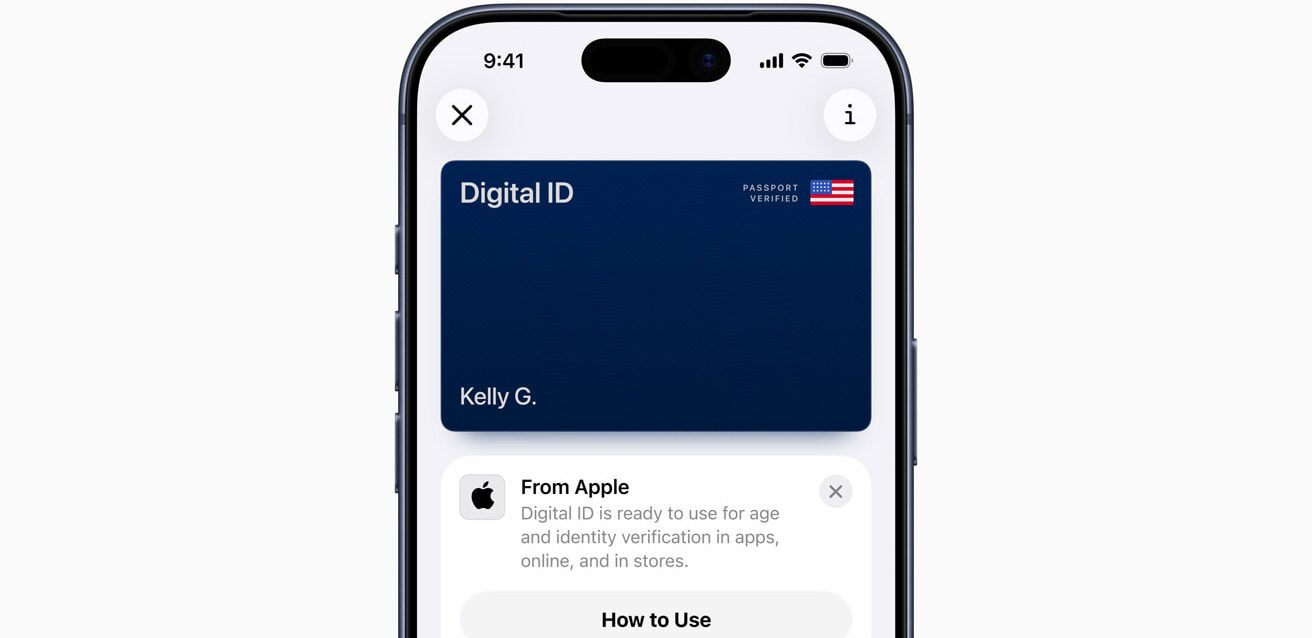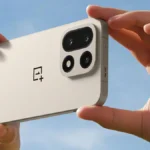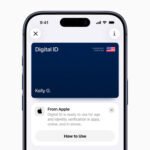Apple Digital ID Passport
Breaking: Apple launched Digital ID for U.S. passport holders on November 12, 2025, marking the most significant expansion of iPhone identity verification since driver’s licenses arrived in Wallet in 2022. This comprehensive guide examines the technical architecture, privacy implications, adoption roadmap, and strategic significance of Apple’s passport-based Digital ID as it rolls out to over 250 TSA checkpoints nationwide.
The timing proves strategic. With REAL ID enforcement now mandatory for domestic air travel and millions of Americans lacking compliant state IDs, Apple’s passport-based Digital ID addresses a critical gap in U.S. identity infrastructure. This analysis draws on Apple’s official announcement, technical specifications, privacy expert assessments, and international digital ID precedents to provide the definitive resource on this developing technology.
What Is Apple Digital ID and How Does It Work?
Apple Digital ID represents a cryptographically secured digital identity credential created using information extracted from your U.S. passport and stored locally on your iPhone or Apple Watch. Unlike simply photographing your passport, Digital ID leverages the RFID chip embedded in modern U.S. passports to verify authenticity while creating an encrypted identity token that can be selectively disclosed during verification transactions.

The distinction matters significantly. Digital ID is not a digital passport—it cannot be used for international travel, border crossings, or situations requiring actual passport presentation. Rather, it functions as a domestically-accepted identity verification tool derived from passport data, similar to how a passport card supplements but doesn’t replace a passport book.
Jennifer Bailey, Apple’s VP of Apple Pay and Apple Wallet, framed Digital ID as expanding access: “Since introducing the ability to add a driver’s license or state ID to Apple Wallet in 2022, we’ve seen how much users love having their ID right on their devices. Digital ID brings this secure and convenient option to even more users across the country, as they can now add an ID to Wallet using information from their U.S. passport.”
The technical architecture employs established standards while implementing Apple-specific privacy protections. Digital ID uses biometric authentication (Face ID or Touch ID), encrypted local storage, and selective disclosure protocols that share only requested identity attributes rather than complete credential data.
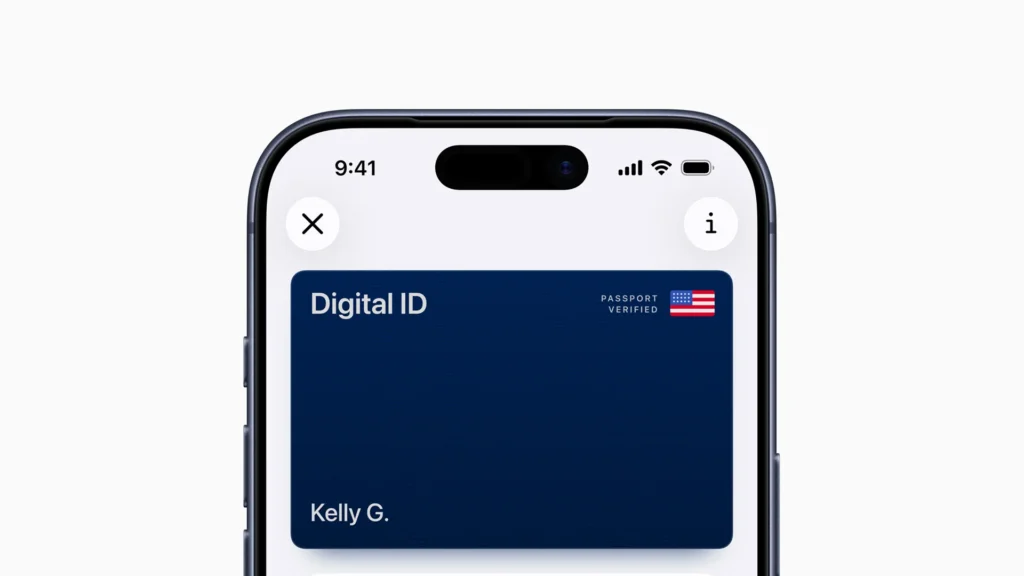
Technical Setup Process and Requirements
Creating a Digital ID requires specific hardware and software configurations alongside your physical U.S. passport:
Hardware Requirements:
- iPhone 11 or later running iOS 26.1 or later
- Apple Watch Series 6 or later running watchOS 26.1 or later
- Face ID or Touch ID enabled
- Bluetooth activated
- Two-factor authentication configured on Apple Account
Document Requirements:
- Unexpired U.S. passport (passport book, not passport card)
- The passport must contain a functional RFID chip (all U.S. passports issued since 2007)
Step-by-Step Setup Process:
- Initiate Addition: Open Wallet app, tap the Add (+) button in upper-right corner, select “Driver’s License or ID Cards,” then choose “Digital ID”
- Passport Scanning: Position your iPhone camera over the passport’s photo page (the page containing your photo, personal information, and machine-readable zone). The app automatically detects and captures this information.
- Chip Reading: Place your iPhone against the back cover of your closed passport. The NFC reader scans the embedded RFID chip, which contains encrypted versions of your passport data and a digital signature from the issuing authority. This step verifies the passport’s authenticity and hasn’t been tampered with.
- Identity Verification: Take a selfie using your iPhone’s camera. The system analyzes this image against the passport photo to confirm identity match.
- Liveness Detection: Complete a series of facial movements and head rotations. This liveness detection prevents photo-based spoofing attacks where someone might attempt to use a photo of you rather than appearing in person.
- Processing: Apple’s servers process the verification request. According to 9to5Mac, verification typically completes within minutes, after which the Digital ID appears in Wallet.
The multi-layered verification process addresses sophisticated fraud attempts while maintaining reasonable user friction. The passport chip reading proves particularly important—counterfeit passports lack properly signed chips, making this verification step a critical security control.
Where and How to Use Digital ID
At launch, Digital ID acceptance focuses on Transportation Security Administration (TSA) checkpoints at more than 250 U.S. airports. TechCrunch reports the feature remains in beta status, meaning device readers haven’t fully deployed to all checkpoint lanes at supported airports.
Current Acceptance:
- TSA PreCheck lanes at participating airports
- Standard security checkpoints at supported airports
- Domestic flight verification only (no international travel)
Presentation Process:
The interaction mirrors Apple Pay’s familiar workflow. At a TSA checkpoint:
- Activate: Double-click the iPhone’s side button (or Home button on older models) to bring up Wallet
- Select: Choose your Digital ID from available cards
- Position: Hold your iPhone or Apple Watch near the TSA identity reader
- Review: The screen displays exactly what information the TSA is requesting (typically name, photo, and age verification)
- Authenticate: Use Face ID or Touch ID to authorize the information transfer
- Complete: The reader confirms verification without requiring you to unlock, show, or hand over your device
This presentation method addresses a key privacy concern with physical IDs. When you hand a bartender your driver’s license to verify age, they can see your home address, exact birthdate, organ donor status, and other information beyond what’s necessary for age verification. Digital ID implements selective disclosure—sharing only the minimum data required for the specific verification.
Apple emphasizes you never unlock your phone, display your screen to the verifier, or surrender physical control of your device. The cryptographic exchange occurs via NFC, with the reader extracting only the authorized attributes while your device maintains full security posture.
Future Acceptance:
Apple indicates Digital ID will expand to “additional select businesses and organizations for identity and age verification in person, in apps, and online.” Potential use cases include:
- Age Verification: Alcohol purchases, tobacco sales, casino entry, mature content access
- Identity Verification: Hotel check-in, car rental, bank account opening
- Access Control: Building entry, event admission, membership verification
- Online Verification: Account creation, financial services, age-restricted purchases
The expansion timeline remains unspecified, though Apple’s history with driver’s license rollout suggests gradual deployment as businesses implement compatible verification infrastructure.
Privacy Architecture and Security Features
Apple’s Digital ID implementation incorporates multiple privacy-preserving technologies addressing concerns raised by civil liberties organizations about digital identity systems.
Local Storage and Encryption:
All Digital ID data stores exclusively on-device using Apple’s Secure Enclave, a dedicated hardware security processor isolated from the main system. The Secure Enclave handles cryptographic operations and biometric authentication without exposing raw data to the operating system or apps.
Passport data extracted during setup encrypts immediately and never transmits to Apple’s servers in unencrypted form. Apple explicitly states it “cannot see when and where users present their ID or what data was presented.” This architectural decision addresses ACLU concerns about “phone home” functionality that enables government tracking of ID presentations.
Selective Disclosure:
Digital ID implements privacy-preserving protocols that share only requested attributes. When a verifier requests “age over 21,” the system returns a cryptographic proof of this fact without revealing your exact birthdate. When TSA requests identity verification, it receives name, photo, and verification status without accessing unrelated passport information like travel history or passport issuance details.
This selective disclosure represents a significant privacy improvement over physical credential presentations, where you must show your complete ID to verify any single attribute.
Biometric Authentication:
Every Digital ID presentation requires biometric authentication via Face ID or Touch ID. This ensures only the legitimate credential holder can present the ID, even if someone gains possession of your unlocked device. The biometric data never leaves your device or becomes accessible to verifiers.
No Third-Party Access:
Apple’s implementation prevents third-party apps from accessing Digital ID data. Unlike some digital identity frameworks where apps can request and store identity information, Apple Wallet maintains exclusive control over Digital ID access and presentation.
Privacy Concerns and Civil Liberties Implications
Despite Apple’s privacy protections, digital identity systems raise legitimate civil liberties concerns that experts and advocacy organizations continue highlighting.
Surveillance and Tracking Risks:
The American Civil Liberties Union warns that digital IDs risk creating “Orwellian nightmares” if designed with “phone home” capabilities allowing governments to track ID presentations. Over 80 organizations signed a statement opposing surveillance features in digital identity systems.
While Apple’s current architecture avoids centralized tracking, critics note nothing legally prevents future iOS updates from adding tracking capabilities. The infrastructure exists—changing the policy requires only software modifications.
Data Breach Vulnerabilities:
Centralized digital identity systems create attractive targets for sophisticated attackers. The 2023 Aadhaar breach in India exposed uniquely identifiable information for 850 million people, demonstrating the catastrophic potential of large-scale identity system compromises.
Apple’s decentralized approach—storing data locally rather than centrally—mitigates but doesn’t eliminate this risk. Device theft, malware, or operating system vulnerabilities could potentially compromise Digital ID data.
Digital Exclusion:
Digital ID systems inherently require smartphones, creating barriers for populations lacking devices or digital literacy. Elderly populations, low-income communities, and those choosing not to own smartphones face potential exclusion from services accepting only digital credentials.
The UK’s digital ID proposal faces significant opposition partly on digital exclusion grounds, with critics arguing mandatory digital IDs disproportionately burden vulnerable populations.
Scope Creep:
Digital identity infrastructure built for convenient airport verification can expand into broader surveillance applications. History shows identity systems initially designed for limited purposes often expand far beyond original intent.
Privacy advocates at StateScoop emphasize: “If this capability exists within a digital identity system, even inactively, it will eventually be used.” This principle suggests vigilance remains essential even when initial implementations include strong privacy protections.
International Digital ID Landscape
Apple’s Digital ID launches amid a global proliferation of national digital identity systems, each offering lessons about implementation challenges and privacy implications.

Estonia’s e-ID Card:
Estonia pioneered digital identity in 2002, achieving nearly universal adoption with 99% of citizens holding digital ID cards. The system enables digital signatures, e-voting, healthcare access, and government services. However, a 2017 security vulnerability affecting encryption keys required replacing 760,000 cards, demonstrating that even mature systems face security challenges.
India’s Aadhaar:
India’s biometric ID system covers over 1.3 billion residents, making it the world’s largest digital identity infrastructure. The system uses fingerprints and iris scans for authentication, with over 1 billion financial transactions completed through face authentication as of early 2025.
Privacy concerns persist. The October 2023 data breach exposed 850 million records. Critics argue the centralized demographic and biometric database creates unprecedented surveillance risks with minimal oversight.
European Union eID:
The EU’s eIDAS regulation establishes cross-border recognition of electronic identification, enabling citizens to use national digital IDs across member states. Implementation varies significantly by country, with some using smart cards, others mobile apps, and varying levels of biometric authentication.
Japan’s My Number Card:
Launched in 2016, Japan’s My Number Card integrates government services, healthcare, and financial transactions. The IC chip-based system simplifies tax filings, social insurance, and bank account setup. Adoption reached approximately 60% of the population by 2025.
UK Digital ID (Proposed):
The UK’s planned mandatory digital ID for Right to Work checks by 2029 faces fierce opposition, with 2.9 million petition signatures protesting the scheme. Critics cite surveillance risks, digital exclusion concerns, and cost questions, demonstrating how digital ID proposals trigger significant public resistance even in technologically advanced democracies.
These international examples illuminate common patterns: initial enthusiasm, gradual adoption, security incidents exposing vulnerabilities, scope expansion beyond original purposes, and ongoing privacy debates. Apple’s implementation can learn from these precedents while avoiding their pitfalls.
Comparison to Existing Wallet ID Systems
Digital ID extends Apple Wallet’s existing government ID capabilities, which currently support driver’s licenses and state IDs in 12 U.S. states plus Puerto Rico and Japan’s My Number Card.
State-Issued Digital Driver’s Licenses:
States offering Wallet-compatible driver’s licenses include Arizona, California, Colorado, Georgia, Hawaii, Iowa, Kentucky, Maryland, Mississippi, Ohio, Oklahoma, and West Virginia. Puerto Rico also participates.
These implementations require state DMV verification and typically mirror the passport-based Digital ID setup process: document scanning, chip reading (if applicable), biometric verification, and liveness detection.
Key Differences:
- Availability: State licenses require residing in participating states; Digital ID works with any U.S. passport
- Federal Acceptance: TSA accepts both, but passport-based Digital ID may expand to federal services faster than state IDs
- Privacy: Both use similar Apple privacy architectures, though state systems may retain verification logs
- International Recognition: Neither serves for international travel, but passport-derived Digital ID may eventually support consular services
Strategic Positioning:
By basing Digital ID on passports rather than only state licenses, Apple addresses a critical gap. Approximately 37% of Americans hold valid passports, while millions lack REAL ID-compliant licenses. Digital ID provides these passport holders an identity verification option even if their state hasn’t implemented digital driver’s licenses.
REAL ID Implications and Compliance
The REAL ID Act, passed in 2005 and fully enforced as of May 7, 2025, requires federally compliant identification for domestic air travel and federal facility access. States must issue licenses and IDs meeting specific security standards, including machine-readable technology and verified identity documentation.
Digital ID addresses REAL ID requirements for passport holders who may lack compliant state-issued licenses. TSA confirms that Digital IDs based on U.S. passports meet federal identity verification standards for domestic flights, providing an alternative to obtaining REAL ID-compliant driver’s licenses.
This proves particularly valuable for:
- College students: Living temporarily in states where they don’t hold licenses
- Military families: Frequently relocating between states
- Recent movers: Who haven’t yet updated licenses in new states
- International residents: American citizens living abroad who maintain passports but not U.S. driver’s licenses
- Non-drivers: Who never obtained licenses but hold passports
Digital ID effectively extends REAL ID compliance to millions who might otherwise face barriers to domestic air travel.
Technical Standards and Interoperability
Digital ID implements multiple technical standards ensuring security and potential future interoperability:
ISO/IEC 18013-5:2021:
This International Organization for Standardization (ISO) standard defines mobile driver’s license (mDL) implementations. However, privacy advocates have raised concerns about the standard’s “phone home” requirements that enable tracking.
Apple’s implementation appears to follow the standard’s credential format while omitting controversial tracking features, though complete technical specifications remain unpublished.
NIST SP 800-63:
The National Institute of Standards and Technology’s Digital Identity Guidelines establish identity assurance levels (IALs) for federal systems. Digital ID likely targets IAL2, which requires either remote or in-person identity proofing and meets requirements for most federal services.
W3C Verifiable Credentials:
Future iterations may incorporate W3C Verifiable Credentials standards, enabling broader interoperability with non-Apple systems while maintaining privacy protections. Current implementation appears Apple-proprietary, limiting cross-platform portability.
Business and Adoption Implications
Digital ID’s success depends on acceptance infrastructure deployment beyond TSA checkpoints. Several factors will determine adoption velocity:
Merchant Acceptance:
Retailers, bars, and businesses must install compatible verification readers to accept Digital IDs. The installed base of NFC payment terminals provides a foundation, but identity verification requires specialized readers meeting security and privacy standards.
Early adopters will likely include:
- Airport businesses: Duty-free shops, restaurants, and bars can leverage existing TSA infrastructure
- Hotel chains: Where identity verification is routine and major brands can justify reader deployments
- Rental car companies: Particularly at airports where TSA acceptance is established
- Stadiums and venues: High-volume age verification makes reader investment economically justified
Regulatory Frameworks:
State alcohol control authorities, banking regulators, and other agencies must explicitly authorize Digital ID acceptance for regulated identity verification. Without regulatory clarity, businesses risk non-compliance by accepting digital credentials.
Biden’s 2025 executive order on digital identity security promotes federal acceptance and provides state funding for mobile driver’s license programs, potentially accelerating Digital ID adoption across government services.
Privacy Regulations:
Businesses accepting Digital IDs must comply with state privacy laws regarding biometric data collection, identity verification logs, and customer data retention. California’s CCPA, Illinois’ BIPA, and emerging state biometric privacy laws create complex compliance landscapes.
User Experience and Practical Considerations
Real-world Digital ID usage involves trade-offs between convenience and practical limitations:
Advantages:
- No physical document: Eliminates risks of forgetting, losing, or damaging passport
- Selective disclosure: Shares only necessary information
- Faster verification: NFC transactions complete in seconds
- Battery independence: Works even with dead phone battery (on Apple Watch)
- Backup option: Can maintain both physical and digital credentials
Limitations:
- International travel: Physical passport remains mandatory
- Legal proceedings: Courts may require physical credentials
- Age restriction purchases: Many retailers haven’t deployed compatible readers
- Banking services: Account opening may require physical documents
- Backup necessity: Should always carry physical ID during initial rollout
Battery Concerns:
Apple Watch can present Digital IDs even when iPhone battery dies, providing redundancy. However, Apple Watch battery depletion leaves users without digital credentials, making physical ID backup essential for travel.
Privacy-Preserving Technologies
Digital ID incorporates several cutting-edge privacy technologies worth understanding:
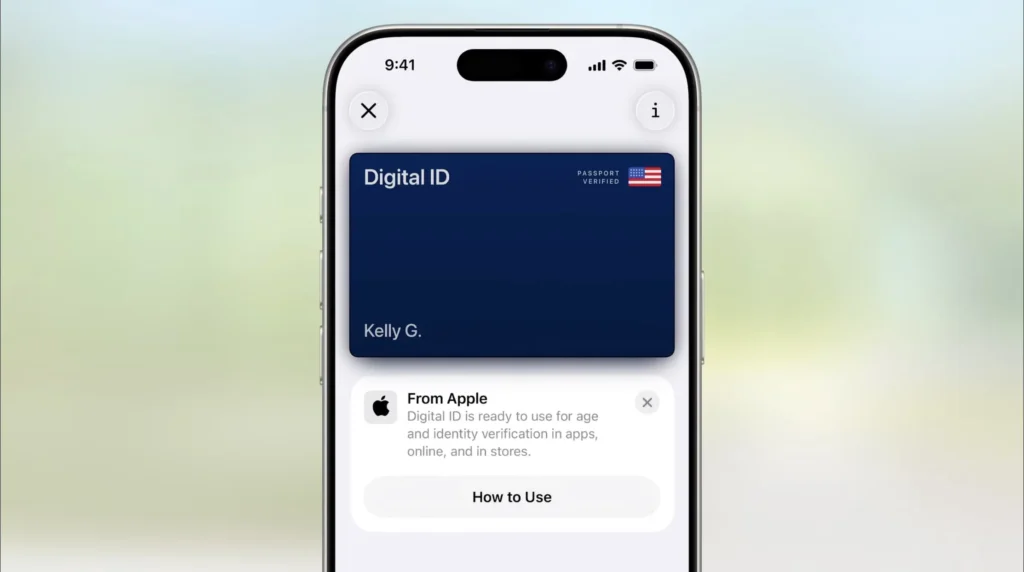
Zero-Knowledge Proofs:
These cryptographic techniques allow proving statements (like “I am over 21”) without revealing the underlying data (your exact birthdate). NIST defines zero-knowledge proofs as mathematical methods confirming transaction validity without exposing specific information content.
Differential Privacy:
This technique adds statistical “noise” to datasets, allowing aggregate analysis while protecting individual privacy. Apple uses differential privacy extensively across its services.
Secure Enclave:
Apple’s dedicated security processor provides hardware-based isolation for cryptographic operations and biometric data. The Secure Enclave’s physical separation from the main processor makes extracting sensitive data exceptionally difficult even with device access.
Future Roadmap and Expansion Plans
Apple’s long-term Digital ID vision extends far beyond airport checkpoints:
Government Services:
Federal and state benefits applications, tax filing, healthcare enrollment, and other government services could accept Digital ID for remote identity verification. The Social Security Administration, IRS, and state unemployment offices represent high-value targets.
Financial Services:
Bank account opening, loan applications, and brokerage account setup currently require in-person identity verification or physical document uploads. Digital ID could streamline these processes while meeting Know Your Customer (KYC) regulations.
Age-Restricted Commerce:
Online age verification for alcohol delivery, tobacco purchases, gambling sites, and mature content represents a massive potential market. Digital ID’s selective disclosure enables proving age without revealing identity.
Access Control:
Corporate office buildings, apartment complexes, gated communities, and event venues could accept Digital ID for entry authorization, replacing physical access cards.
Healthcare:
Patient identification, prescription verification, and healthcare portal access could integrate Digital ID, reducing administrative friction while maintaining HIPAA compliance.
International Expansion:
While current Digital ID is U.S.-only, international passport acceptance could follow. However, cross-border identity verification introduces complex regulatory and standardization challenges.
Frequently Asked Questions
Does Digital ID replace my physical passport?
No. Digital ID cannot be used for international travel, border crossings, or any situation requiring physical passport presentation. Always carry your physical passport when traveling internationally or when passport presentation is legally mandated.
What happens if my phone battery dies at the airport?
If you have an Apple Watch with Digital ID configured, it functions independently of your iPhone. Otherwise, you must present your physical ID. The TSA recommends always carrying physical identification as backup during the Digital ID beta period.
Can I use Digital ID if I don’t have a REAL ID driver’s license?
Yes. Digital ID provides an alternative identity verification method for domestic air travel even without a REAL ID-compliant driver’s license, addressing the May 7, 2025 REAL ID deadline for air travel.
How secure is Digital ID compared to physical passports?
Digital ID offers several security advantages: biometric authentication prevents unauthorized use, encryption protects data, and selective disclosure limits information exposure. However, it introduces new attack vectors including malware and OS vulnerabilities. Neither physical nor digital credentials are perfectly secure.
Can businesses track when I use Digital ID?
Individual businesses receiving identity verification information can log that you verified your identity with them. However, Apple’s architecture prevents centralized tracking across multiple verification events. Businesses cannot see where else you’ve used Digital ID.
Will Digital ID work on Android devices?
No. Digital ID is exclusively for iPhone and Apple Watch. Google Wallet supports mobile driver’s licenses in some states, but passport-based digital IDs remain Apple-only as of late 2025.
What states support digital driver’s licenses in Apple Wallet?
As of November 2025, 12 states (Arizona, California, Colorado, Georgia, Hawaii, Iowa, Kentucky, Maryland, Mississippi, Ohio, Oklahoma, West Virginia) plus Puerto Rico support adding driver’s licenses to Apple Wallet. Digital ID based on passports works regardless of your state.
Does using Digital ID speed up TSA screening?
Potentially. Digital ID transactions complete faster than physical document inspection. However, TSA officers may take longer initially due to unfamiliarity with the technology. TSA PreCheck members will likely see the most benefit.
Conclusion: The Digital Identity Transformation
Apple’s Digital ID launch represents a significant milestone in the gradual digitization of identity credentials, but serious questions remain about privacy, security, and civil liberties implications of widespread digital identity adoption.
The technical implementation demonstrates Apple’s commitment to privacy-preserving architecture. Local storage, selective disclosure, biometric authentication, and no-tracking design address many concerns raised by civil liberties organizations about digital ID systems. Apple’s track record with privacy-focused product design provides some reassurance that commercial incentives align with user privacy.
However, structural concerns persist. The infrastructure enabling convenient identity verification can be repurposed for surveillance with policy changes alone. Legal protections, not just technical architecture, ultimately determine whether digital identity systems respect civil liberties or enable authoritarianism.
International experience demonstrates that digital identity systems evolve far beyond initial scope. Estonia’s e-ID card now enables everything from voting to healthcare to banking. India’s Aadhaar expanded from welfare distribution to become a comprehensive national identifier despite Supreme Court restrictions. Scope creep appears nearly inevitable regardless of initial promises.
The practical question for individuals isn’t whether to embrace or reject digital identity—the infrastructure is being built regardless of individual preferences. Rather, it’s how to participate while protecting privacy and maintaining alternative options. Never surrendering your physical passport, understanding exactly what information you’re sharing, and supporting legislative privacy protections represent prudent approaches.
For policymakers and technologists, Apple’s Digital ID demonstrates that privacy-preserving digital identity is technically feasible. The remaining question is whether legal frameworks will mandate privacy protections or allow surveillance capabilities to proliferate. The answer will determine whether digital identity liberates or enslaves in the decades ahead.
As Digital ID expands from airport checkpoints to age verification to government services, its architecture will establish precedents shaping digital identity globally. Getting these foundational decisions right matters immensely—not just for iPhone users but for the future of privacy and civil liberties in an increasingly digital world.

